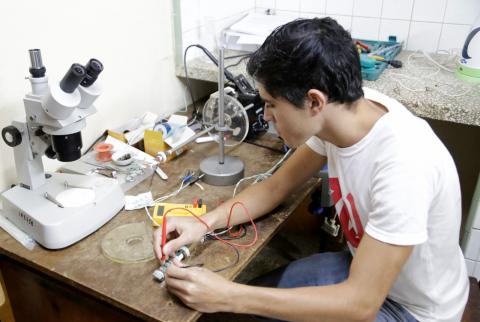
The use of the Brick Wall model at the time of understanding the processes that take place during the superconducting transition of Bi-2223 ceramics is the first study to be defended in Cuba after having conducted all the measurements in the Physical Characterization Laboratory equipped by the VLIR project at the Universidad de Oriente.
Ricardo Mesa Enríquez, candidate to the Bachelor in Physics degree, who is due to graduate in the next few days, explains that the research is intended to optimize the properties of these materials. "It is necessary to improve its electrical transport properties, which is why it has been important to use the equipment donated by the VLIR project, by means of which it has been possible to measure, for instance, the resistivity values (the opposition to the passage of current). Since these materials pass to the superconducting state at low temperatures (approximately -173 degrees Celsius), resistivity versus temperature curves have been obtained ".
The Diploma Paper provides the design of a support in which the superconducting sample is mounted.”It is a copper rod. The sample is activated with a given value of electrical current intensity and measured with a simple configuration, which is the four-point configuration. Thus, the voltage value at the ends is determined and the properties of the sample get to be characterized. The support is introduced into a sheath; the air is withdrawn thereof and immersed into liquid nitrogen. It is important that measurements are made in the vacuum because the water steam can jeopardize the measurement".
According to Mesa Enríquez, studies on superconductors are of paramount importance to science since their application is widespread in the transmission of electrical energy and in the construction of specialized medical equipment such as nuclear magnetic resonance tomography machines.
For now, Cuba gains ground in the theoretical studies as well as in the training of professionals in the subject, since its introduction in the industry requires of major modernizations in the same.
The Diploma Work provides the design of a support in which the superconducting sample is assembled and the whole measurement is performed.
Since 2014 the Vlir project contributes to the equipment of this laboratory, which makes possible the increase of research on the application of electric superconductors in the country
This is the first pre-degree thesis that the UO contributes after all the measurements have been carried out in the Physical Characterization Laboratory equipped by the VLIR project. Photos: Eduardo Pinto
Translator: Maite Elisa Palacios Herrera.

